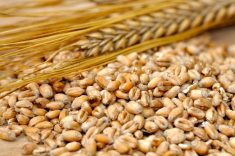Compared to last week, western Canadian yearling markets traded $2-$3 on either side of unchanged; steer calves under 700 lbs. were steady to $2 higher on average; heifer calves were steady to $5 higher.
Southern Alberta, along with the western half of Alberta, received 30-40 mm of rain over the week which enhanced demand for lighter-weight feeder cattle. Farmers and ranchers were aggressive on grassers and cow-calf pairs. Recent rains have also increased the probability for average-type wheat and barley yields. It now looks like the barley crop could reach 11 million tonnes, which will easily satisfy domestic and export demand.
Read Also

U.S. livestock: Feeder cattle hit contract highs on tight supply
Chicago | Reuters – All Chicago Mercantile Exchange feeder cattle futures and most live cattle futures hit contract highs on…
Finishing feedlots were also anxious to secure ownership of feeders under 800 lbs. Strength in deferred live cattle futures exacerbated ownership desires. U.S buying interest was also evident with favourable crop ratings for U.S. corn. The steer-heifer spread appeared to narrow for calves. This isn’t unusual when supplies tighten and ranchers start purchasing replacements for herd expansion. This brings another segment of demand into the market. Alberta packers were buying fed cattle on a dressed basis in the range of $290-$292 delivered, up $1-$4 from last week’s trade.
Angus-based mixed steers with medium flesh on small grain ration weighing a shade under 1,000 lbs. were quoted at $180 in the Lethbridge area; similar-quality and -genetic heifers averaging 930 lbs. were quoted at $166 in the same region. In central Alberta, a small group of tan mixed steers with medium flesh on small grain and hay diet with full health records weighing 820 lbs. were valued at $210. South of Edmonton, Hereford-based heifers on forage diet with medium to lower flesh averaging 800 lbs. were quoted at $182. The yearling market was hard to define in Saskatchewan and Manitoba due to limited numbers on offer. In most cases, the small packages available sold $3-$4 below average prices in central Alberta.
North of Red Deer, a small group of Charolais-blended steers on forage ration with full health details averaging 740 lbs. sold for a whopping $227. This was about $7 above average prices for this weight as mixed steers averaging 730 lbs. were quoted at $220. Larger-frame Angus-based heifers on forage diet with full health details weighing 750 lbs. were valued at $190 in central Alberta.
Supplies of calves under 600 lbs. were limited across the Prairies. In southern Alberta, Simmental-blended steers weighing 560 lbs. were traded hands at $242 and similar-quality heifers weighing 540 lbs. dropped the gavel at $220. Southeast of Calgary, Limousin-based steers averaging 630 lbs. were valued at $241 landed in the feedyard and mixed heifers weighing 650 lbs. were quoted at $192.
For the week ending May 28, Canadian feeder cattle exports to the U.S. were 115,960 head, up 204 per cent from only 38,159 head last year. The CME composite price, which is the official cash settlement price for CME feeder cattle futures, has jumped nearly US$6 from June 1.
— Jerry Klassen is president and founder of Resilient Capital, specializing in proprietary commodity futures trading and market analysis. Jerry consults with feedlots on risk management and writes a weekly cattle market commentary. He can be reached at 204-504-8339 or via his website at ResilCapital.com.















